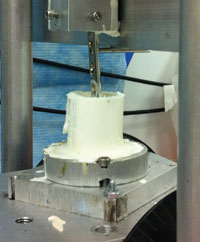Study shows poor survival of locking screws when placed in bent locking plates
SAN ANTONIO — Locking screws showed decreased survivorship when used in locking plates that were bent at a locking hole of more than 5°, according to the results of a study presented at the 2011 Annual Meeting of the Orthopaedic Trauma Association.
“Plate bending greater than 5° can significantly compromise the function of a locking screw,” Christina L. Boulton, MD, said during her presentation. “Caution should be taken with screw placement through bent locking holes, and the surgeon should be cognizant that bending can compromise locking screw function and adjust fixation strategy accordingly.”
For their study, Boulton and colleagues questioned whether bending locking plates changed the biomechanical properties of the locked screw-hole unit.
“Operative technique often requires plate bending intraoperatively to contour the plate to the bone or to aid in fracture reduction,” Boulton said. “However, little is known about the effects of bending on locking screw function.”
|
|
|
|
An experimental construct within the testing MTS load frame is shown here. The image on the left shows a 3.5-mm Synthes LCP plate bent to 45° with a locking screw in place after failure has occurred. The screw angle has toggled significantly from its horizontal starting trajectory. The image on the right shows a 3.5-mm Synthes LCP plate control (with no bend) before loading. Images: Boulton CL |
|
Boulton and colleagues tested samples of small fragment 3.5-mm locking compression plates with a single coronal bend with bend apexes at a locking hole. They contoured each test sample at 5°, 15° or 45° and added an extra test group bent at 45° with a locking screw-hole insert in place before bending. They then used a step-wise cyclic loading protocol of 10,000 cycles or until failure to test 10 plate samples for each group vs. non-bent controls. The team measured the outcomes of protocol survival and mean number of cycles survived.
The team found significant differences between the 15° and 45° groups and controls. The mean number of cycles survived was poorer for all bent plates, Boulton said. Analysis of variance showed a statistically significant difference between groups. The 5° plate group revealed 16% lower survival of mean cycles to failure than controls, but Boulton noted that this difference was not statistically significant. When comparing the test group with a locking screw-hole insert placed prior to bending at 45° to the normal 45° group, the team found no significant difference in mean number of cycles survived or protocol survival.
“Our findings in the study were threefold,” Boulton said. “Number one, plate bending significantly changes the biomechanical properties of a locked screw. Number two, locking screw function is significantly affected only after a threshold of acceptable bend is exceeded. And number three, the effects of plate bending cannot be prevented by placement of a threaded screw head insert prior to bending.” – by Renee Blisard
Reference:
- Boulton CL, Kim H, Shah SB, et al. Do locked screws work in bent plates? Paper #39. Presented at the 2011 Annual Meeting of the Orthopaedic Trauma Association. Oct. 12-15. San Antonio.

- Christina L. Boulton, MD, can be reached at University of Maryland Medical Center, 22 South Greene St., Baltimore, MD 21201; 410-328-6280; email: cboulton@umoa.umm.edu.
- Disclosure: Boulton has no relevant financial disclosures.



